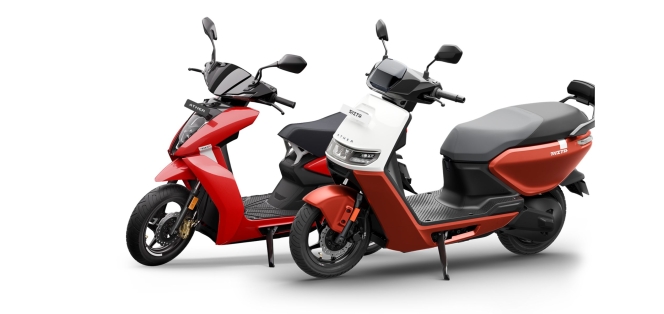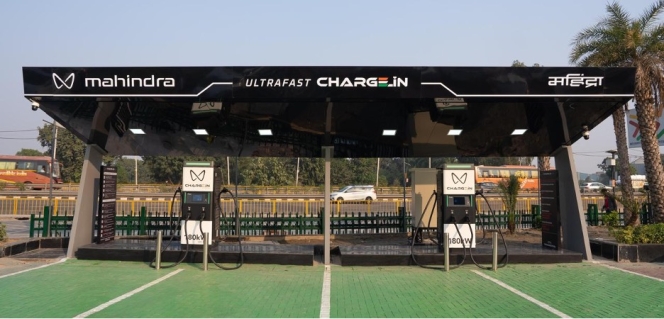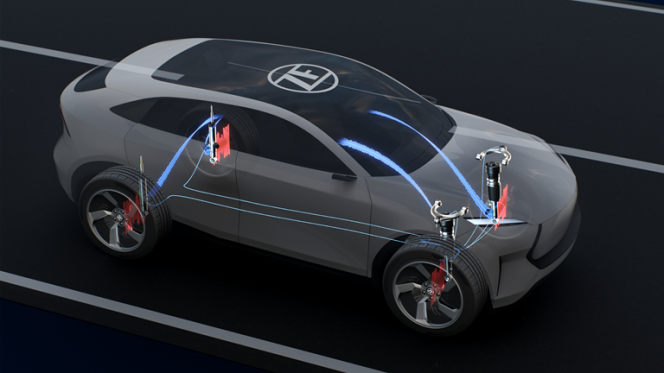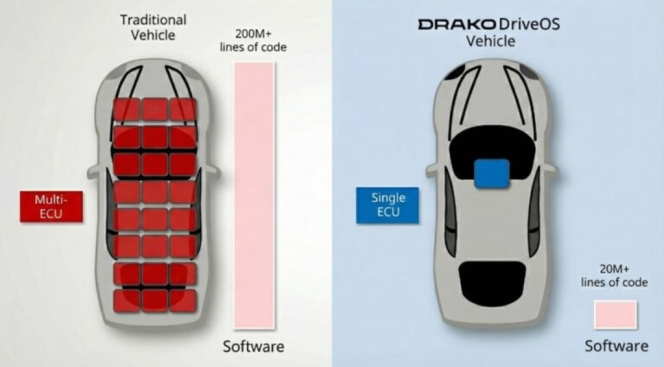Becoming Smarter And Sustainable
- By Juili Eklahare
- September 13, 2022

Bosch has always been known for its cutting-edge technology, including in the mobility sector. The company completed 100 years in India this year and has also come up with a new smart campus called Spark.NXT, which was launched in July this year in Bengaluru, India. Spark.NXT has several parts to it, along with sustainability and mobility being a prominent focus.
Bosch, a leading supplier of technology and services, has been bringing together comprehensive expertise in vehicle technology with hardware, software and services to offer complete mobility solutions. The Bosch mobility solutions web portal presents highlights from the areas of connected mobility, automated mobility and powertrain systems and electrified mobility. In fact, Bosch is present in all of the mobility segments in India – from passenger vehicles to heavy commercial vehicles and light commercial vehicles to three-wheelers and two-wheelers.
Adding another feather to its cap will be one of the latest steps of the company – expanding its artificial intelligence of things (AIoT) activities in India by transforming its headquarters in Adugodi, Bengaluru, into a new smart campus called Spark.NXT. The inauguration of the same took place in Bengaluru, India, in July this year, also with the company celebrating 100 years of Bosch in India.
Throwing light on Bosch completing 100 years on Indian soil, Soumitra Bhattacharya, Managing Director at Bosch Limited and President of the Bosch Group, India, averred, “In terms of automotives, we have moved from an automotive components manufacturer to a systems manufacturer to a solutions manufacturer.”
Over the last five years, Bosch has invested INR 8 billion in developing the campus, which has the capacity to potentially house 10,000 associates. The 76-acre site is Bosch’s first smart campus in India and features multiple smart solutions based on sustainability, security and user experience for associates, visitors and facility management. It is designed to adapt to the needs of the users, and the smart solutions are innovated on the foundation of Bosch’s technological know-how.
In truth, in the construction phase, a strong emphasis was placed on recyclable materials and the transplanting of trees, ensuring an increase in green cover.
As an AIoT company, Bosch India leveraged its world-class artificial intelligence (AI), internet of things (IoT), automation and digitalisation capabilities to develop its smart campus in pursuit of its vision for a sustainable, self-reliant and future-ready India. To further enhance its R&D capabilities for the new way of working, the company has also trained over 10,000 associates through a comprehensive reskilling initiative over the past two years.
Spark.NXT – what is it?
Bhattacharya explained that Spark. NXT is a curiosity to transition and transform, and to meet the business expectations of not only grabbing the opportunities but co-creating the opportunities of the future.
Filiz Albrecht, Member of the Board of Management and Director of Industrial Relations at Robert Bosch GmbH, who officially took responsibility for Bosch India from 1 July 2022, talked about Spark. NXT and asserted, “Spark.NXT demonstrates our commitment to both sustainability and the well-being of our associates. It features a variety of smart IoT and machine learning (ML) solutions, which are expected to cut energy consumption on the campus by nearly 30 percent. The new campus will be an inspiring environment for our associates that will help them unleash their creativity and spark future innovations.”
In his inaugural speech, the Indian Prime Minister, Narendra Modi, said that the Bosch Spark.NXT campus will certainly take the lead in developing futuristic products and solutions for India and the world. “I am happy that Bosch India has worked not only on innovation but also in giving it scale,” he said and added, “A key pillar in this will be sustainability. I was told that Bosch has achieved carbon neutrality both in India and outside of the country, which is very inspiring. Bosch came to India 100 years ago as a German company, and now it is as much Indian as German. This is a great example of German engineering and Indian energy.”
Spark.NXT has been broken into six parts – Spark.Mobility, Spark.Living, Spark.Industry, Spark.Software, Spark.Sustainability and Spark. Culture.
Spark.Mobility
“In mobility, we are talking of green mobility under four core factors – personalised, automated, connected and electrified,” Bhattacharya enlightened and continued, “For the last 12 years, we have worked on safety and reducing road accidents very closely with the Government of India.”
Spark.NXT and collaboration
Bhattacharya further put across that they are trying to do obsessive collaboration, not just with their customers or start-ups but for their group companies. “Many of these legal entities are currently, and will be further, housed inside the campus. We work together with software and hardware engineers, look at what the customers need and co-create the solutions,” he elucidated and continued, “Today, it’s all about where people get together and co-create through collaboration and also create opportunities.”
Giving a concrete example, Bhattacharya said, “Let’s take the example of driver drowsiness in some vehicles. So the emergency brakes, the cockpits, the connectivity and the various aspects that we will further announce in the areas of hydrogen electrification are all simple but clear examples of what we are trying to do.”
“So this campus, with this environment, allows us to get not just internal collaboration but external collaboration as well,” he stated.
Bosch’s sustainable practices
Albrecht further stated that the Bosch Group is a leading global supplier of technology and services. “We have 128 locations across the globe and the company generated a sale of EUR 78.7 billion in 2021,” she shared and went on, “Bosch is a value-driven company and our commitment to sustainability is an integral part of the corporate culture. The key for us is technology, and as an innovation leader, we develop products and solutions of outstanding quality that help conserve natural resources and improve the quality of life.”
Albrecht went on to mention that as a company, Bosch has a long history of sustainable practices. She asserted, “Sustainability is no longer just a ‘nice to have’. Today, sustainability is our core mission, and we are working hard to live up to our responsibility here. By acting in an economically, environmentally and socially responsible manner, we want to improve the quality of life of the present and future generations as well. The Bosch Group has been carbon neutral since 2020.”
Focusing on carbon neutrality
“While making our own operations carbon neutral was in itself a big step, we are now focusing our efforts on reducing emissions outside of our direct sphere of influence,” Albrecht asserted and continued, “We are aiming to reduce our annual upstream and downstream emissions by 15 percent by 2030. To achieve this, we are, firstly, pursuing a circular economy strategy that involves keeping materials and products into usability for as long as possible. Secondly, we are striving to optimise energy efficiency in our existing products. And thirdly, we are shifting our product portfolio towards carbon neutrality.”
Coming to Bosch India, Albrecht cited that it is playing a key role in carbon neutrality, water management and energy efficiency, and that the people at Bosch India are doing some inspiring work in sustainability. While sustainability is central to a company’s corporate strategy, its success depends on the people. Bosch India wants to create an environment that enables its associates to develop their full potential and contribute to the company’s long-term success. It is preparing its associates for the transformation and helping them to develop personally and acquire new skills.
Investment in electromobility, digitalisation and more
“One more area of focus is reskilling associates and preparing them for the technologies of the future,” Albrecht informed and continued, “Over the past five years, Bosch has invested EUR one billion in this and plans to invest another billion in artificial intelligence, electromobility, software, digitalisation and Industry 4.0, to name just a few, over the next five years. Here as well, India is playing a key role for both our company and the global arena. The country has an advantage of demography and the availability of talent that can power global solutions.”
The importance of diversity
She went on to aver that when it comes to their workforce, they are convinced that their tremendous diversity is one of their most important factors of success. As a global player, Bosch has associates from some 150 different countries, and diversity is one of the core values of the company. The company is working hard at all levels of the Bosch Group to increase its diversity further by also bringing in women in leadership roles.
Coming to India, Albrecht said, “India is a highly diverse country, with a variety of cultures and languages. We believe that India’s diversity is key to its engine of innovation, and we’ll continue to invest in our local workforce in the years to come."
Bosch’s presence in Karnataka
Bhattacharya spoke of the company’s presence in Karnataka and mentioned that Bosch has the largest R&D centre in the world (outside of Germany) in Karnataka and that Bosch Global Software Solutions is headquartered in Koramangala. “Our collaboration with the Government of Karnataka has been there for a very long period,” he mentioned.
He further highlighted, “We transitioned the country from BSIV to BSVI in a record time of three years, where Europe and other countries took eight years. We have also worked very closely with the Government of India for Make in India and Aatmanirbhar Bharat.”
The Chief Minister of Karnataka, Basavaraj Bommai, who was the Chief Guest at the ceremony, applauded the work done by Bosch India, especially in Karnataka. He asserted, “It is a pleasure to be part of the inauguration of the Spark. NXT Campus of Bosch India. The company has had its presence in the state for several decades now, and it is heartening to host India’s largest smart campus here. Karnataka, primarily Bengaluru, has been a technology hub and houses the largest number of R&D centres across the globe. This campus is another feather to its cap.”
The chief minister further added, “This campus showcases R&D capabilities for both automotive and non-automotive products and services, and I hope that this will elevate the city’s leadership in the field of technology to a greater level.”
Campus walkthrough
The media was even given a walkthrough of the new smart campus, taking them through three of the solutions – Bosch Air Quality Management, Smart Working Solution and Visitor Management System.
Bosch Air Quality Management – Bosch India has already taken a lot of measures inside the new campus to reduce the impact of air pollution. Some of the measures include increased green cover (by 30 percent) and increased green energy – the company has made its entire campus a non-motorised zone. Plus, it has some new initiatives, like paperless work culture, planned.
However, in order to understand the effect of the emissions surrounding the campus (traffic, construction etc.) on the campus, the company has deployed its air quality monitors inside the campus and regularly monitors the data. This data is provided to the associates and is available as real-time information. The data is also made available to visitors on a big screen in the lobby etc.
Smart Working Solution – With the hybrid working model becoming the new norm, this opens up opportunities to reduce some real estate costs by decreasing the number of desks available. Naturally, it becomes important for the associates to know if there are desks available before they go to the office. Therefore, in order to facilitate this kind of flexible working model, Bosch India has come up with a smart solution, ‘Flexi Booking App’. Through this application, associates can check the availability of the desks and book the same from the comfort of their homes.
Another smart solution that Bosch India has come up with is ‘Automated Comfort Assistant’ application. Through this application, associates can provide feedback on how they feel about the office temperature (too hot, too cold etc.), and the system automatically adjusts the temperature based on this feedback so that everyone feels comfortable.
The combination of these two solutions gives real-time usage for facility management to optimise the workplace. This eventually helps in a considerable reduction in the cost of the real estate.
Visitor Management System – The Smart Visitor Management Solution scans a visitor’s face and gives automatic access. Plus, this solution also has a smart locker that works on a QR-based system – when an employee sends an invite to a visitor, the visitor gets a QR code on their mobile. The visitor just has to show the QR code as smart locker and a locker is assigned to them. There is no manual intervention involved; it's all automated.
The benefit of this solution is that it gives the visitor a seamless experience – there is zero dependency and enhanced security.
In order to make the solution much smarter, the company also wants to implement geo fencing (so that visitors do not go into any areas of the campus where they are not supposed to go), go cardless and include a robot to assist visitors around the campus.
Ather Energy’s New Subsidiary To Focus On Auto Insurance Business
- By MT Bureau
- December 19, 2025

Bengaluru-based electric vehicle maker Ather Energy has confirmed its plans to enter the auto insurance services space by incorporating a wholly-owned subsidiary that will operate as a Corporate Agent.
The move is part of the EV maker’s plans to owmake nership experience more seamless, by providing auto insurance policies, in partnership with multiple insurers. This will also provide a recurring revenue stream by leveraging its existing user base.
Ather Energy also aims to innovative around EV-specific insurance products, simplify renewals and also improve attach rates over time.
Ravneet Singh Phokela, Chief Business Officer, Ather Energy, said, “We have always believed that a good ownership experience goes beyond the vehicle itself. Insurance is a critical part of that journey today, and it’s an area where the experience can be made significantly simpler and more predictable for customers. By bringing insurance distribution closer to the Ather ecosystem, we can make it simpler, more transparent, and better aligned with how our customers actually use their vehicles. Over time, this also gives us the ability to work with partners to design auto insurance products that reflect real EV usage, rather than adapting legacy frameworks. This is a measured but deliberate step, focused on strengthening the ownership experience while building a capability that complements our core offering and scales with the business.”
The EV maker stated that this move is a natural extension, as it can utilise its large customer base, which equates to no additional customer acquisition cost.
Ather Energy stated that entering the auto insurance space is part of its larger EV ecosystem building mission, which goes beyond just selling products, charging infrastructure, servicing and accessories among others.
Exicom Launches Exciom One EV Charging Rollout Solution
- By MT Bureau
- December 18, 2025

Exicom Tele-Systems has introduced Exicom One, a solution for the construction and operation of electric vehicle charging infrastructure. The service handles site surveys, electrical setup, software, operations and maintenance.
The launch coincides with the expansion of charging networks by Charge Point Operators (CPOs) in India. These organisations plan to deploy chargers, including DC units, by 2030.
The solution provides a framework for infrastructure deployment by combining hardware and software. The company is providing end-to-end support right from site assessment & planning for pre-installation, to civil works, electrical integration and hardware setup for deployment. It also provides AI-driven management, diagnostics and maintenance to support the EV charging operations.
Exicom One manages the orchestration of firmware and software. The platform allows businesses to monitor and optimise stations in real time.
The company recently partnered with an EV manufacturer to install charging stations along highway corridors and at traffic points. The infrastructure is designed to integrate renewable energy systems and Vehicle-to-Grid (V2G) applications.
The service also utilises Harmony Connect, an AI platform for predictive maintenance.
Anant Nahata, Managing Director and CEO, Exicom, said, “India’s EV story will only move as fast as the infrastructure behind it. While hardware innovation gets most of the attention, it is execution on the ground that truly defines success. Exicom One is built to remove that friction by bringing every piece of the puzzle together under one accountable partner. It is a smarter, faster way for CPOs and fleets to scale with confidence and focus on what really matters: delivering reliable charging experiences.”
ZF To Present Software Active Noise Reduction For Vehicle Chassis At CES
- By MT Bureau
- December 17, 2025

German tier 1 supplier ZF is presenting a new ‘Active Noise Reduction’ software function for vehicle chassis at the Consumer Electronics Show (CES) 2026. The purely software-based function reduces in-vehicle tyre noise transmitted through chassis components without requiring additional hardware. The company plans to expand the use of the function to other ZF chassis actuators in the future.
The solution uses ZF’s Smart Chassis Sensor with an integrated acceleration sensor to measure vibrations from the tyres. A developed algorithm recognises the characteristic noise patterns of tyre cavity noise around 200 hertz.
The software generates a counter-signal via ZF’s cubiX software through the valves of semi-active dampers (CDC). The function uses micro-movements of the damper to specifically reduce noise interference without impairing the damper function.
The technology achieves noise reductions of more than 3 dB, with future potential for up to 10 dB. This software-based noise reduction is achieved without additional installation costs or space requirements. Active Noise Reduction can be adapted to different vehicle types via software, opening a market for lower-priced vehicles.
Dr. Peter Holdmann, Member of the ZF Board of Management and Head of Division Chassis Solutions, said, “Active Noise Reduction is an excellent example of how we use smart algorithms to make ZF components even more efficient. This gives our semi-active CDC dampers a clear unique selling point in the market and sets new standards in comfort – without the need for any additional noise dampening hardware.”
Series production is scheduled to start in 2028. In the future, the function may be used in other ZF actuators, such as for active reduction of brake squeal.
Holdmann added, “Thanks to our system expertise, we are able to offer our mechatronic actuators as true innovation drivers with the help of smart algorithms and we will extend our software-based control approach to other ZF actuators in the future. The goal for us is clear: mechatronic actuators that are capable of efficiently reducing both their own and external noise with the help of software.”
The new function fits into ZF’s Chassis 2.0 product strategy, which uses intelligent and networkable actuators to enable new chassis functions via software.
Holdmann noted: “With our Chassis 2.0, we are laying the foundation for the software-defined vehicle.”
Drako Tech Unveils DriveOS With Single-ECU Architecture
- By MT Bureau
- December 17, 2025

California-based Drako Tech has announced DriveOS with HyperSafety, an automotive operating system designed for single-Electronic Control Unit (ECU) operation. The platform consolidates vehicle subsystems, including control systems, ADAS and digital cockpit, into one unit to reduce costs and enable over-the-air (OTA) updates.
Launched in 2015 and utilised in Drako GTE and Drako Dragon vehicles, DriveOS supports internal combustion, electric and hybrid propulsion systems.
The HyperSafety system provides real-time performance via a single-ECU architecture. According to Drako Tech, the networking backbone facilitates communication four times faster than multi-ECU Time-Sensitive Networking (TSN) automotive Ethernet.
The architecture employs hardware isolation and redundancy to maintain operation during component failures. By using a reduced code footprint and hardware partitioning, the platform aims to limit attack surfaces for cyber security and streamline validation processes.
Industry Integration
Drako Tech provides development environments that run natively on DriveOS:
- Control Systems: Allows engineers to build vehicle controls from Simulink models.
- Digital Cockpit: A system for instrument clusters, navigation and multimedia.
- ADAS: A software foundation for driver assistance with low-latency control.
The platform addresses the complexity of multi-ECU architectures, which typically require separate units for functions such as seats, doors and thermal management. Drako Tech uses a separation kernel to run safety-critical systems alongside non-critical systems, such as infotainment, on the same ECU.
DriveOS introduces hard real-time capabilities to Linux without requiring kernel changes. This allows developers to use Linux libraries and tools for safety-critical systems.
Key features include:
- Performance: 108-microsecond end-to-end performance compared to 514 microseconds for TSN Ethernet.
- Consolidation: The ability to move functions onto a single PC architecture to reduce hardware mass and complexity.
- Redundancy: Hardware-backed isolation ensures faults in one subsystem do not affect driving functions.
- Cloud Integration: Real-time fleet management and diagnostics without creating access paths to control systems.
Dean Drako, CEO, Drako Tech, said, “Nearly half of the cost of new vehicles is tied up in software and electronics. Drako Tech now offers all OEMs worldwide – regardless of size or influence – a definitive leap in their ability to deliver exceptionally safe, connected, AI-enhanced vehicles, with massive cost advantages. We are the first to achieve the ultimate goal – a single-ECU, hard real-time operating system and unified electronics architecture with mixed criticality – while providing OEMs a flexible deployment path.”






Comments (0)
ADD COMMENT